|
Rochester Road
Cuxton
01634 789969
https://www.whitehartcuxton.co.uk/
https://whatpub.com/white-hart
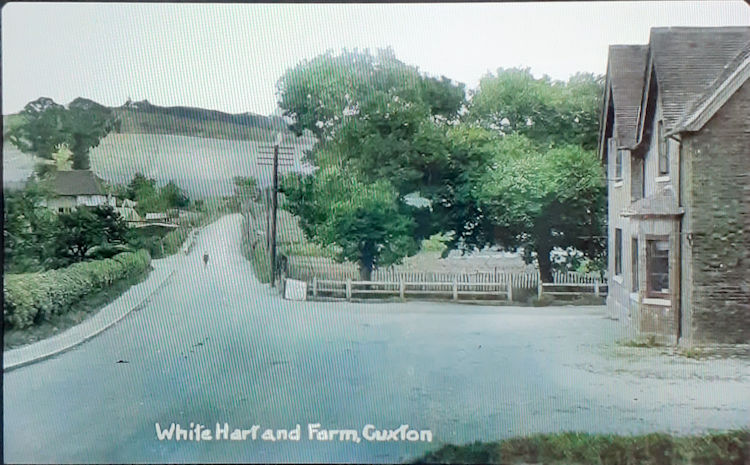
Above postcard, date unknown. |
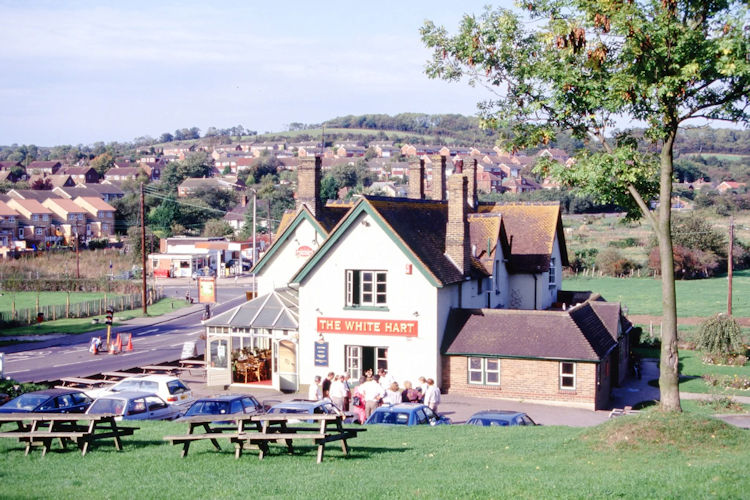
Above photo, 1982. |
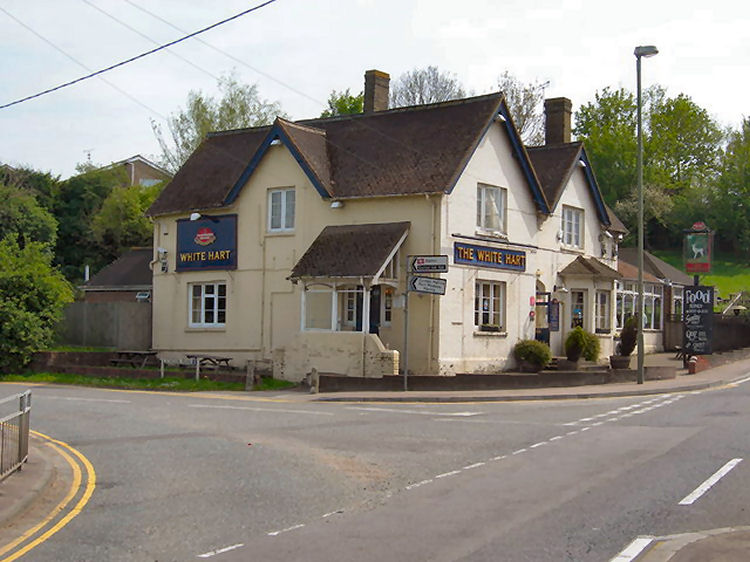
Photo by Danny Robinson 2008 from
http://www.flickr.com. |

Above photo 2012 by Nigel Chadwick
Creative Commons Licence. |
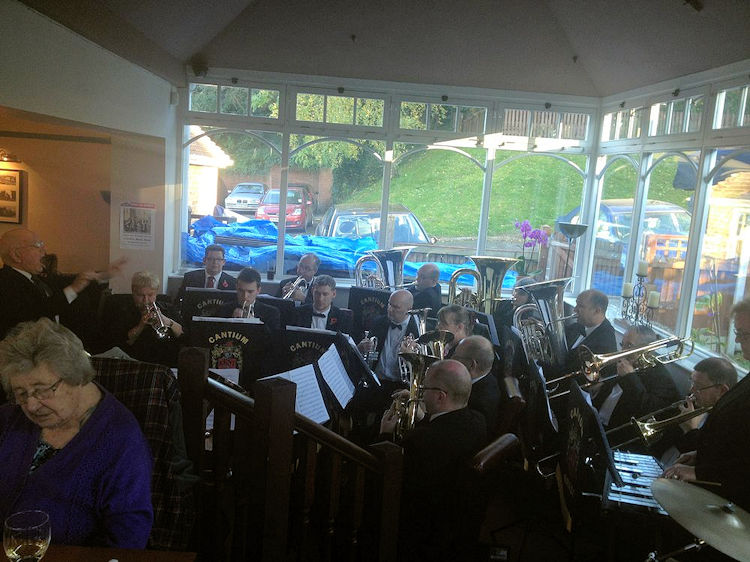
Above photo, showing a Remembrance Day Lunch, 2014. |
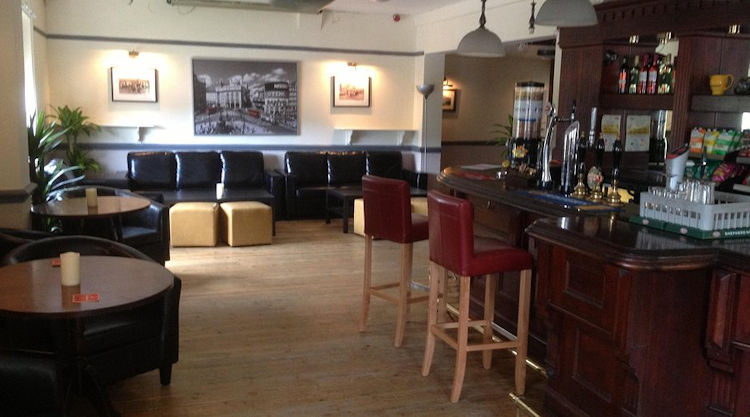
Above photo 2014. |
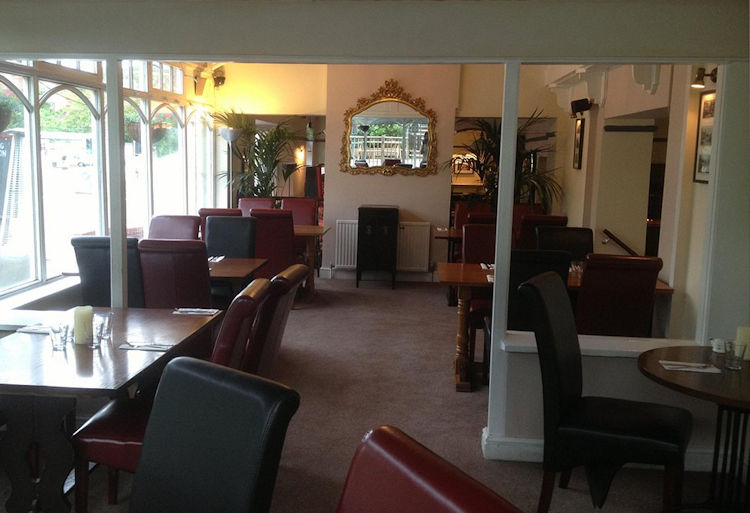
Above photo 2014. |

Above photo 2021. |
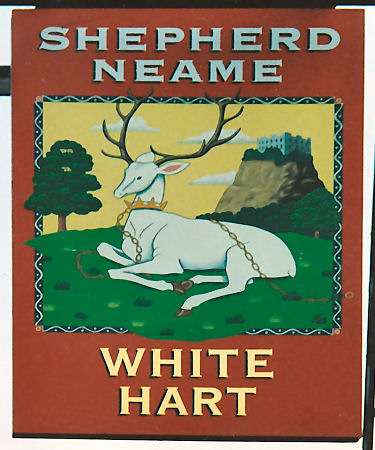 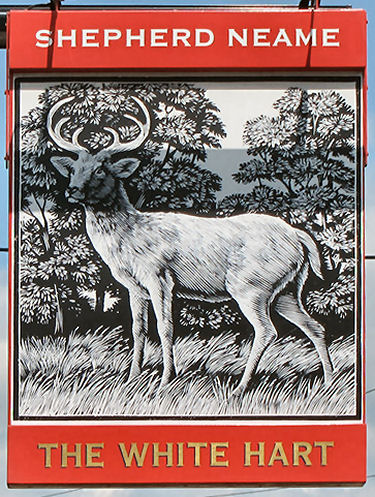
Above sign left, August 1992. Sign right, 2011. |
One of the most popular pub names. The "White Hart" is a white deer stag
and was the personal emblem and livery of Richard II, who derived it from
the arms of his mother, Joan "The Fair Maid of Kent", heiress of Edmund of
Woodstock.
The following passage states that the pub was built in 1860, however, a
book titled "Cuxton A Kentish Village" by Derek Church, gives a list of
licensees of the pub, and the earliest is listed as 1839, indicating that
there was a pub with that name that preceded this one.
One time a Mason's tied house, but the brewery was bought out by Shepherd
Neame in 1956 and the brewery was subsequently closed and demolished.
|
Kentish Gazette, 8 March 1814.
Lime works, Whorns Place, Kent. - 900,000 Bricks, Carts, Horses,
Furnitures &c.
To be sold by auction, by Mr Phillips, on the premises, Whorns place,
Cuxton, near Rochester, on Friday, 18th of March inst. by order of the
Proprietor, at twelve, 900,000 of Malm, Stock, and Place Bricks, of
superior quality for building and fronting of Houses &c. conveniently
placed for shipping by the side of the Medway, two miles from Rochester,
which will be allotted in quantities, suitable to every class of
purchasers.
Also all the stock for carrying on the Lime and Brick Trade on an
extensive scale; consisting of five capital Cart Horses with their
Harness, a useful Hackney, three Brarges, with a Rigging, Tall Boats,
Anchors, Cables, &c, four Carts, and a large quantity of various Tools
for conducting the above concern.
May be viewed two days preceding the Sale, and Catalogues had on the
premises, the "White Hart," Cuxton, principal Innes, Rochester, Chatham,
and Gravesend; and at Mr. Phillips's Estate and Auction Office, 73, New
Bond Street, London.
|
|
From Cuxton A Kentish Village by Derek Church. The present "White
Hart" public house dates from 1860. The previous building was burned
down and the new pub followed roughly the same plan-shape, in fact, I
wonder if the old foundations were used.
Mr Jupp was the licensee and he was followed by Mary and Sarah
Peters. Sarah, who was always known as Sally, bought the pub from Lord
Darnley. She was a kindly, round faced, short person who would always
send round some beef tea to anyone who was ill in the village. She also
gave a supper to the bell-ringers every year. Mary, her sister, was a
little odd and died in a fire under rather mysterious circumstances.
During this period Tom Peak, known as Potty Peak, was ‘potboy' and used
to regularly clean all the pewter tankards, or pots, and put them out to
dry on the Station Road fence, one pot to each fence spile. When Sally
died, the pub was bought by Masons, the brewers from Maidstone, for the,
then, large sum of £8,000. George Antrim ran the "White Hart" for many
years and then after the war, Bill Bennett took over and continued as
licensee until quite recently.
At the rear of the pub is a timber-framed and weather-boarded
building known as The Long Room. This has had many uses including a
football changing room, when football was played in the Station Road
meadow, a reception room, a dance hall and a venue for concerts. Three
inquests have also been held here.
Alongside the pub are a substantial range of stables, for when the
pub was first built all transport on the roads was horse propelled. More
recently this has been used as garaging and storage space, and for many
years the village's only petrol filling station was adjacent to this
building.
At one time beds were always available at the "White Hart," which as
an inn had by law to provide overnight accommodation for travellers. On
several occasions a horseman who had had too much to drink stayed on for
the night. This reminds me of the Horse named Doctor who was owned by a
Hailing doctor and was eventually sold to Hilliers Dairy. Even while
executing his new duties he would always come to a halt outside the
"White Hart" and refused to budge until he had been given what a local
inhabitant described as ‘a livener'.
After the First World War a branch of the Royal Antediluvian Order of
Buffaloes was formed in Cuxton and held their meetings in a large room
on the First floor of the pub. The buffaloes were a sort of working-mans
freemasonry and the Cuxton lodge, number 414B, was at first, very
active. It seems to have fallen off a bit during the depression but
carried on until the beginning of the last war. One of its
best-remembered members was Bill Stiance who seems to have acquired the
title of Mayor of Cuxton during this period. He was always in the
forefront of any village reforms and often trod out footpaths that had
been ploughed up. Tod Overy was onetime secretary of the lodge and his
place was taken by Ted Allcom who still proudly keeps his medals and
certificates.
On the bank behind the "White Hart" is a curious small building, the
walls of which are constructed of mud, a material much used for building
purposes in the West Country but which is little used around here. What
remains of the roof structure seems to be composed of old ships timbers
and perhaps this isn't so surprising because Mr Jupp, Sally Peter's
uncle, and a previous licensee, did a bit of boat-building here. These
boats were pulled down the old landway which led to ‘Noahs Ark' and
which can still be traced on the ground in places. By a strange
coincidence, much more recently, Colin Cogger used this very building as
cover when he built his own sailing cruiser in 1965. The land way had by
this time disappeared, so Colin dragged his boat to the river along
Station Road. Another feature which has now gone is the village pond
which was situated opposite the pub alongside Station Road.
This went when Station Road and the main road were widened and made
up in the early 1920s. Before that time, as reference to an early
photograph will show, the environs of the "White Hart" were much more
attractive. Adjacent to the pond were some fine elm trees and in front
of it was a smart white-painted rail fence.
|
|
Extracts from
http://www.kentcrp.org.uk/cuxtonwalk.pdf
WHITE HART PUB
Roman beginnings and wartime memories.
The "White Hart" pub was built in 1860. During construction,
considerable finds of Roman pottery were made. The finds are now lost
but it is recorded that one of the vessels had the name of the potter,
Matemus, stamped on it.
The Lost Landscapes project received a contribution that included a
personal account of the "White Hart" written by Lilian Bennett, who
first went to live at the pub in 1914. She recalled how this part of the
village looked then:-
"At that time the "White Hart" grounds stretched right across to the
station on one side, and almost to the Vicarage drive on Church Hill.
There was not a house in sight, but the marsh today is almost the same
as it was then... Then there were the hops, all up one side of the
village street (Bush Road) and extending past the school..."
Lilian recorded memories from both World Wars...
From WWI:
"Suddenly 'Big Lizzie' (the gun on the other side of the river)
pounded away. The whole pub shook... As we looked out of the window we
saw a Zeppelin which my aunt said was probably going towards London."
From WWII:-
"I decided to go to the woods to get some blackberries, and while
there the air raid warning sounded. A huge black bomber swooped
overhead, with spitfires after it... I cowered in the hedge, bullets
were flying everywhere... In a few minutes it was all over... I decided
to carry on picking blackberries and about 5 o'clock, headed for home.
When I got to the top of Church Hill, I stopped in amazement outside the
pub were crowds of people. I raced down the hill - I thought the pub had
been hit... Not so. What had been hit or merely grazed, was Court Lodge,
home of Shorts drawing offices [Shorts was an aircraft manufacturer
based in the area]... The staff had left in a body and were now gathered
outside the "White Hart" expecting to be let in and provided with
brandy!'
These extracts are taken from Cuxton Remembered by Lilian Bennett. |
|
Kentish Gazette 03 February 1852.
THE LATE MYSTERIOUS CASE.
The adjourned inquest on the body found under such mysterious
circumstances, in the river Medway, on the 10th inst., was resumed at
the Guildhall, Rochester, on Monday, before Mr. Lewes, the coroner.
Since the last inquiry it has been ascertained deceased's name was John
Brown, aged 38, late a marine on board H.M.S. London. The first witness
called was John Langworthy, who identified the body by the clothes. The
deceased was discharged from the London, on the 12th November last, when
he stated his intention of obtaining his discharge, having served 21
years, and then to enter the same ship as an able seaman. Witness
received a letter from him on the 14th of November, but never saw him
after. Deceased was a single man and had when he left the ship a £5
note, 2 sovereigns and some silver. Mr. S. Steele, surgeon, had examined
the body, which had been in the water at least 6 weeks, but the state
the body was in, would only admit of a partial examination. He had no
doubt the deceased came by his death by submersion. John Webb, a marine,
saw the deceased at Sheerness, he then went to witness's house, where he
drank very much, and appeared in low spirits. Deceased went to bed, but
in the afternoon he would go out, and witness never saw him again. James
Allen, another marine, met the deceased next day in High street,
Chatham. Joseph Grover, an ostler at the "White Hart," Cuxton, proved
finding the body in the river. He and his brother placed a rope round
the head, and towed it to the side of a boat, having procured a stake
they drove it into the mud tying the body to it, intending to take it
ashore afterwards, as they were engaged on board their master's barge at
the time. On going there in about an hour and a half after-wards, they
found it had floated away. After a few observations from the Coroner,
the jury returned a verdict of "Found Drowned."
|
|
Maidstone Telegraph 28 July 1860.
CUXTON. DISCOVERY OF ROMAN REMAINS.
In recently excavating the foundations for a new inn at Cuxton, on the
site of the "White Hart," the workmen dug up a quantity of Roman
pottery, probably the remains of a sepulchral interment. It consisted of
five or six paterae and cups of the red glazed ware, commonly called "Samian,"
an urn (which probably contained the burnt bones), and a smaller
urn-shaped vessel in dark-coloured clay. Two of the red dishes bore the
potters' names, one of which was imperfectly stamped and illegible. The
other is Maternus, a name which occurs in the list of Roman potter's
names found in the late excavations made in the city of London, and
published by Mr. Roach Smith in his "Collectanea Antiqu." The vessels
discovered are now in the possession of the Earl of Darnley. — Bulder.
|
|
Dover Express 18 June 1864.
ROCHESTER. The FATAL BOAT ACCIDENT ON THE MEDWAY.
The adjourned inquest on the bodies of William Thomas Thurlow, Ebenezer
Gibbons and Elizabeth Holland, who were drowned by the upsetting of a
boat in the Medway on, the 5th inst., was held on Monday afternoon last
by Bower Marsh, Esq., deputy coroner.
Edward Jupp, landlord of the "White
Hart," Cuxton, deposed to having heard of the accident between twelve and
one in the afternoon. Witness immediately took a boat and a net, and
with two of his men proceeded to the part of the river where the
accident occurred, and discovered the bodies of the deceased about six
feet apart.
Edward Young, station master at Cuxton, deposed that he saw
the boat capsize, immediately on which he called a porter and another
man named Hymns, who went out in a boat and rescued Mr. Hollands and the
child. Witness immediately took the child into the station, and adopted
the usual means to restore animation. He also telegraphed for a surgeon,
and Mr. Langstone arrived from Stroud. The deceased were all floating
together before they sunk.
William Charted Holland deposed that he was
in charge of the boat, and at the time of the accident they were tacking
about, and the witness engaged stowing the pump away. A sudden squall
took the boat and capsized it, when she filled and went down.
This being
the whole of the evidence, the jury returned a verdict, "That the
deceased were accidentally drowned" and they at the same time
recommended Mr. Holland, if ever he used the boat again, to use smaller
sails therewith."
|
|
Maidstone Journal and Kentish Advertiser, Saturday 10 June 1871.
Halling. Shocking Suicide.
An inquest was held on Wednesday, at the "White Hart Inn," Cuxton, by
T. Hills, Esq., upon the body of Harriet Pointer, who committed suicide
by throwing herself down and well 150 feet deep, in the parish of
Halling, on the previous day.
The deceased had previously attempted self destruction by similar means,
and it seemed had been confined in a lunatic asylum about 4 years ago,
since when time which time she had been strange.
A verdict of temporary insanity was returned.
|
|
From the Kent Burial Records.
Sarah Peters (1843-1919) buried at Cuxton, St. Michael & All Angels, on 26 February
1919, of the "White Hart Inn," Cuxton.
|
|
From the London Standard, 5 October, 1895.
The "White Hart Hotel," Margate.
Messrs Walters, Lovejoy, and Telfer in conjunction with Mr. John
Bailey, auctioneer, of Margate have been favoured with instructions by
Mrs. Fagg to submit to public competition, at the Mason's Hall, Masons
Avenue, Basingstoke-street, London. E.C., on Thursday, November 12, at
1 precisely a free lease for a term of 40 years together with the
Goodwill-in-trade and early
possession of the above valuable property. In directing the attention of
the licence in trade to this sale, the auctioneers have no hesitation in
asserting that Fag's "White Hart Hotel" is probably the most popular and
best known hostelry on the Kentish Coast; and has been in the occupation
of Mrs. Fagg for nearly 60 years, and the proprietress has during
this lengthy period developed and maintained a most
extensive, progressive, and lucrative business. It is quite impossible
within the limits of an advertisement to specify all the advantages
which an hotel such as this can command, but the fact of such a long
and successful occupation by the present owners must convince those
seeking to purchase a first-class business that in facts "White Hart
Hotel" they have an opportunity of acquiring one rarely met with. May
be viewed, by cards only, to be obtained from the Auctioneers, and particulars and conditions of sale when ready may be had of
Walter Hills,
Esq., solicitor, Margate; Messrs Kingsford, Dormer, and Co,
solicitors, 23, Essex Street, Strand; at the Auction Mart, Margate;
on the premises; at the place of Sale; and at the Auction Offices, 9,
Southampton street, Bloomsbury Square, London. |
|
Whitstable Times and Herne Bay Herald 17 August 1940.
Man’s Leg Found at Whitstable.
MUTILATED BODY THAT HAD BEEN DRAGGED FROM NEAR ROCHESTER.
MASTER BAKER'S SUICIDE.
A tragic story was told at an inquest held by Mr. T. B. Bishop (Acting
Coroner for North-East Kent) at "The White Hart." Cuxton, near
Rochester, on Friday afternoon, touching the death of Edgar Honey, aged
72 years, a master baker, of 117 Bill Street Road, Frindsbury,
part of whose mangled body was found on the permanent way of the
Southern Railway, on Thursday, August 8th, near Pebbles' Crossing,
Cuxton, and another portion near Whitstable, the following day.
Herbert Edgar Honey, of 111 Bill Street Road, a baker employed by his
father, gave evidence of identification. He last saw his father alive at
3 p.m. on Wednesday, August 8th, before he (witness) went on his rounds.
His father then appeared as well as he had been for a long time past.
Latterly, deceased appeared to have been depressed as a result of the
war, and had been unable to sleep, and on the advice of Dr. Eric
Greenwood, of Rochester, he had attended the Kent County Hospital at
Chatham on July 29th. On last Wednesday afternoon, however, deceased
told witness that he had had as good a night's sleep as he had enjoyed
for a long time past, and during the afternoon played a game of darts
with witness’ father-in-law. Deceased had a good bakery business and no
domestic worries. He lived by himself, and had never threatened to take
his life. So far as witness knew, deceased had no business or friendship
that would have taken him out Cuxton-way.
Charles William Wickens, of 100, King Street, Rochester, employed by the
Southern Railway, deposed to having found a mutilated body at 7.05 a.m.
on the Thursday morning, at Cuxton. One leg was missing. The body was
lying in the "down" road, right across the four-foot way.
P.C. Ledger. Kent County Constabulary, stationed at Cuxton, deposed to
being called to the scene of the tragedy. The body was almost naked and
the head was lying towards the middle rail. The clothes had been torn
off. Marks on the body indicated that it had been dragged about 75 yards
before it was dropped by the engine of the train. The right leg was
missing, and had been found that (Friday) morning, on the railway line
at Whitstable, which was a good many miles away. The train that had
struck deceased had not yet been traced, and parts of deceased’s
clothing were still missing.
Dr. J. C. Spencer Edwards, of "St Elmo," Halling, described the injuries
on deceased's body, which were of a multiple character. The cause of
death was shock, following a fracture of the skull and laceration of the
brain.
The Coroner returned a verdict of "Suicide, whilst the balance of
deceased’s mind was disturbed."
|
LICENSEE LIST
PARKER Francis to 1837 dec'd
PARKER Mary 1838-41 (age 35 in 1841 ) )
JUPP Edward 1841+74+ (widower age 58 in 1871 ) )
PETERS Miss Sarah 1881-91 (age 48 in 1891 ) )
JUPP Edward & PETERS Sarah 1891-1901+
JUPP Edward 1903+

PETERS Miss Sarah 1911-Feb/19 dec'd (spinster age 68 in 1911 ) )
ANTRUM William Thomas 1922-30+
ANTRUM Herbert George 1938+
BENNETT George "Bill" William 1939-69
https://pubwiki.co.uk/WhiteHart.shtml
 From the Kelly's Directory 1903 From the Kelly's Directory 1903
 Census Census
|









